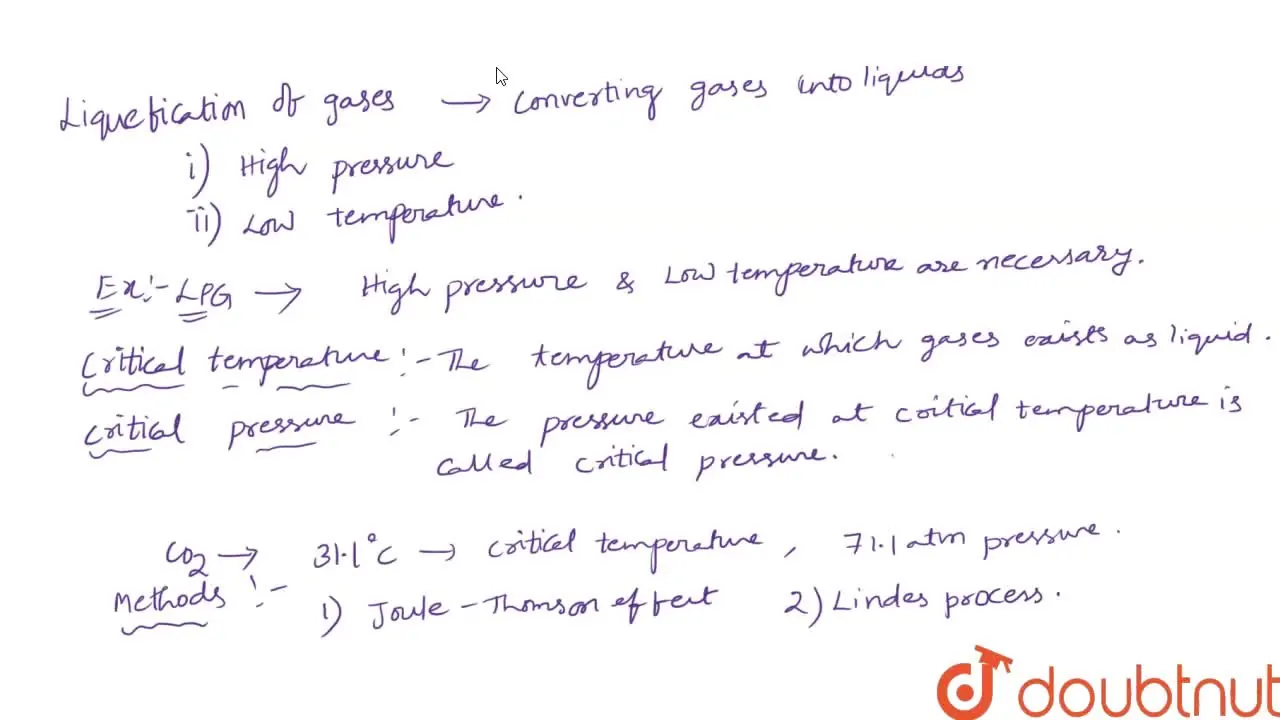Explain the liquefication of gases. Solution in Telugu
Liquification of gases can be done by decreasing the temperature and increasing the pressure.
Liquefaction of gases: Any gas, if it to be liquefied, it must be cooled below its critical temperature. A gas liquefies if it is cooled below its boiling point at given pressure. For example, chlorine at room pressure say 1 atmosphere can be liquefied by cooling it to −34.0∘C in a dry ice bath. For N2 and O2 that have very low boiling points -196∘Cand−183∘C Such simple technique is not possible. Then, to liquify such type of gases the technique based on intermolecular forces is used. It is as • follows. If the velocities of molecules are reduced to such lower values that neighbours can attract each other by their interaction or intermolecular attractions, then the cooled gas will condense to a liquid. For this, the molecules are allowed to expand into available volume without supplying any heat from outside. In this, the molecules have to overcome the attractions of their neighbours and in doing so, the molecules convert some of their kinetic energy into potential energy and (now travel slowly. The average velocity decreases and therefore the temperature of the gas decreases and the gas cools down compared to its temperature before its expansion. For this the gas is allowed to expand through a narrow opening called throttle. This way of cooling of gas by expansion from high pressure side to low pressure is called Joule - Thomson effect.
Related Playlists
- BOOK - VIKRAM PUBLICATION ( ANDHRA PUBLICATION)CHAPTER - STATES OF MATTER GASES AND LIQUIDS EXERCISE - SHORT ANSWER QUESTIONS26videos
STATES OF MATTER GASES AND LIQUIDS
- BOOK - VIKRAM PUBLICATION ( ANDHRA PUBLICATION)CHAPTER - ORGANIC CHEMISTRY SOME BASIC PRINCIPLES AND TECHNIQUES EXERCISE - IMPORTANT QUESTIONS42videos
ORGANIC CHEMISTRY SOME BASIC PRINCIPLES AND TECHNIQUES
- BOOK - VIKRAM PUBLICATION ( ANDHRA PUBLICATION)CHAPTER - STOICHIOMETRY EXERCISE - Important Question39videos
STOICHIOMETRY
Similar Questions
State and explain Boyle's law.
02:24View SolutionWrite the regents required for conversion of benzene to methyl benzene.
02:32View SolutionHow many number of moles of glucose are present in 540 gms of glucose ?
02:23View SolutionThe ease of liquefation of noble gases decrease in the order:
03:00View SolutionGasH2HeO2N2Critical temp. ink33.25.3154.3126
From the above data, what would be the order of liquefication of these gases? Start writing the order for the gas which liquefies first:01:22View SolutionHow does pressure help in the liquefication of a gas ?
View Solutionगैसों के द्रवीकरण के सिद्धांत की व्याख्या करें।
04:18View SolutionNoble gases are inert - explain.
01:55View SolutionThe ease of liquefication of noble gases is in the order:
03:54View Solutionశరీరంలో జరిగే వాయువుల రవాణా విధానాన్ని వివరించండి?
04:00View Solution112ml. of oxygen at STP is subjected to liquefication. The mass of liquid oxygen obtained is
02:09View SolutionExplain the liquefication of gases.
03:04View SolutionWhat is Joule-Thomson effect? How does it help in the liquefication of gases?
02:18View SolutionExplain simplicity of gases.
08:09View SolutionExplain microscopic model of gases.
View SolutionLower the critical temperature of a gas …………. is its rate of liquefation.
04:18View Solution


